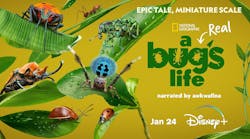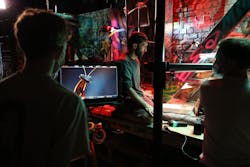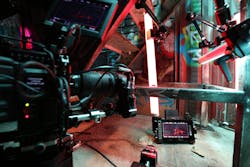What you’ll learn:
- What National Geographic’s new docuseries is about.
- Insight into insect behaviors and their worlds.
- The technologies used to capture those lives.
Pixar’s “A Bug’s Life” debuted on the big screen 25 years ago, and to mark the occasion, National Geographic decided to launch a new series entitled “A Real Bug’s Life”—a close-up look at some of the tiny creatures that inhabit the world. From jumping spiders to praying mantises, the 10-episode series tells their unique stories as they struggle to survive in their respective habitats, including city streets, rainforests, backyards, and the wide-open spaces of the African savannah.
The series, narrated by actress Awkwafina, goes beyond simply showcasing insect lives. It brings viewers into their worlds through the magic of advanced imaging technologies and techniques. From a photographic perspective, capturing intimate details of insects in their micro worlds is an incredible accomplishment, considering those creatures have no affinity to pose for the cameras, and setting up those beautiful shots was an ordeal of its own.
A Medical Path Toward Microphotography
Capturing the point of view from the insect side in tight spaces is no simple task and requires the use of specialized probe lenses initially designed for medical purposes, which are long, thin, and able to maneuver in close quarters. Managing to film those insects in their macrocosm adventures (Fig. 1) marks a dynamic shift from traditional macrophotography through the repurposing of medical technology, which helped to overcome some of the issues associated with confined spaces.
Robotic systems also played a pivotal role in garnering those unique perspectives, allowing the camera operators to produce footage with enhanced precision free of wobbling, which can play havoc when magnified at tiny scales. The robotic systems were operated remotely using PlayStation controllers to help further reduce any image distortion caused by the human operators.
Of course, filming a docuseries of this caliber isn’t without its challenges. Insects are typically not actors and often have their own ideas regardless of the technology introduced into their ecosystems.
On-Location and Controlled Environments
Filming the series was predominantly done on location to capture the insects’ natural behaviors. However, some of the more complex scenes required controlled environments to depict specific interactions.
For example, the camera team spent six months to capture the hatching of cockroach eggs, a first to be caught on camera. After a series of failed attempts, the team decided to use a small incubation system that was set up in a spare bedroom (Fig. 2). They then created a moat system around the incubator so that they couldn’t escape and infest the building where the scene was being shot.
The blend of on-location filming and controlled environment imaging allowed the team to create a series that retains its natural world behavior while delivering engaging content. National Geographic managed to create a compelling series with “A Real Bug’s Life,” and it does so using single insects to tell larger stories.
Producing a series from the insects’ point of view gives viewers insight into the interconnectedness between them and their ecosystems, and the notion that no matter how small, every creature has an importance and impact on the world.
That said, the technology and techniques used to make the series created a new standard in capturing wildlife on a scale never before seen. The innovative use of medical imaging systems and probe lenses demonstrated a new level of how photographers capture scenes in tightly confined spaces and challenging environments. The repurposing of existing technology can have incredible results when imagination and technical insight come together, which pushes the boundaries of what’s possible with microphotography.


